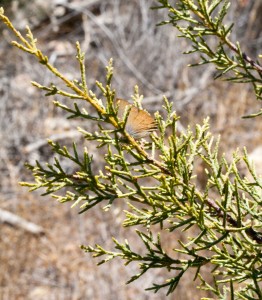Working to Pull a Rare Cypress Back from the Brink of Extinction
Posted in Interesting Plant Stories on January 16, 2015 by Damon Little
Damon P. Little, Ph.D., is Assistant Curator of Bioinformatics in The Lewis B. and Dorothy Cullman Program for Molecular Systematics. In addition to his research projects involving large sets of plant DNA data, he studies the cypress family of conifers.

Last year, I was among a group of land managers and scientists that the Nature Conservancy brought to San Diego to plan for the future of a species that is on the brink of extinction.
Forbes’ cypress (Callitropsis forbesii) has never been particularly common as far as we know. Also known as Tecate cypress, this multi-trunked conifer was first brought to the attention of scientists when it was discovered by a University of California (Berkeley) undergraduate, C. N. Forbes, while hiking near San Diego during his winter break in 1907. Forbes found a single population with only a few scattered trees, but subsequent botanical exploration has turned up a few more populations in southern California and northern Baja California.
By far the largest and most impressive population of Forbes’ cypress covers the upper reaches of Otay Mountain, just east of San Diego and north of the U.S.–Mexico border. In their prime, vast numbers of Forbes’ cypress outcompeted almost all other trees on the mountain, creating a lush, closed canopy of dusky green. That canopy lowered the temperature and increased moisture levels on the forest floor, providing habitat for many other species of plants and animals. Most important, it provided food and shelter for Thorne’s hairstreak, an endangered butterfly that relies on Forbes’ cypress.

